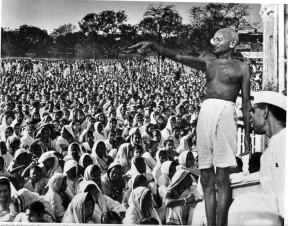When a chord in struck simultaneously in many hearts and a vast number of people are stirred by a common cause, a mass movement is born. A mass movement is triggered because a cause moves the sentiments and/or justifies the rationale of many. It is a breakthrough of the seemingly weak against the so-called powerful. A mass movement leaves a mark on the history of mankind because it changes the fate and the psyche of a considerable number.
If we look at a mass movement keenly, there is an underlying wave of sentiment that runs through it. It is contagious like laughter or tears. It is inexplicable but it spreads. Like fire, it does both. Destruction and regeneration.
A movement may not always entail something good. No matter how clear the intention of the leader may be, no matter how justified the cause may appear, a mass movement could contain the seed of a toxin. At a point of time, one cannot deny, the common populace must have seen the ideology of Nazism and Fascism as a panacea to their miserable lives. They were convinced that their intention to achieve a better life was clear and that their action of unconditionally standing by their leader was justifiable. Few may still want to justify it but perhaps most were too benumbed then to realize that what they had believed to be a patriotic mass movement would in no time turn out to be a massacre.
However a mass movement may also inspire generations to come together and may usher a new leap in the evolution of humankind. The American war of independence (1774) and the French Revolution (1789) inspired the very essence of the modern day democracy viz. life, liberty and pursuit of happiness. The history of India has a baggage of mass movements, big and small, which have kept the fervor of democracy ever alive. After India emerged from the medieval age with the help of the various social reformers, Mahatma Gandhi popularised the philosophy of Satyagraha and took the mass movements into the political sphere too.
These movements not only brought about the feeling of self-respect and nationalism but at the grassroot level also mobilized the people towards constructive programs, hygiene, and kept them away from liquor habituation and other social evils. Certainly the pre-independence mass movements were not only a freedom movement but larger than it.
Since then, the people of India have continued the trend of mass Satyagraha movements to struggle against injustice. These post-independence movements may not be as popular as the pre-independence movements but they express the same sentiment that the people of the nation did prior to independence, namely opposition of suppression.
When a government presumes that it is in a privileged position and is over and above the common man, when a government’s arrogance surpasses the tolerance of the common, a revolution breaks out. Such post-independence mass movements that stood for the cause of common masses were the Chipko Andolan (a socio-ecological movement), the Narmada Bachao Andolan (Gujarat), the Save Silent Valley movement (Palakkad district of Kerala), the Sarvodaya Andolan of Vinoba Bhave (including bhoodhan i.e. donation of land), and the Sampoorna Kranti movement of Jayaprakash Narayan.
Having said this, the dangers of a mass movement are not ruled out. A mass movement can be violent and capricious. A mass may be severely deluded of the reality. Studies state that a mob is guided by a crowd psychology. In a group, an individual looses his/her individuality and a sense of anonymity is generated. This feeling of anonymity allows a member to loose his/her normal constraints on behavior and react impulsively and defiantly. This process of loosing the capacity to behave and think as an individual is termed as `Deindividuation’.
A participant of a mass movement should guard against deindividuation. As the human species is believed to be evolving, the mass movements should also evolve. The mass movements should not only be moved by the sentiments but also be guided by information, knowledge and realistic probable outcomes of the revolution.
This alone will not suffice. Each mass movement should be tested against certain criteria by each individual. These criteria may be summed up as follows: a) a mass movement should not violate the right of individual freedom b) it should not be aimed at oppressing the opponent, c) it should justify the means as well as the end and d) it should not ignore human values like goodness, peace, human dignity and human life.
Nilesh P Megnani is a professor of philosophy who teaches not just the academics of his subject but the purpose of it to his students. He writes whenever he feel inspired and believes life is workable hypothesis and love, the elusive potion that might transform humanity.







The existence of Mass movements is a proof of injustice. And one should know why he/she is being a part of it. The article is eye opening in the conclusive paragraphs where the points are listed. Rationality is a must and the revolution has begun, hopefully will improve the state of the country.
It is always enlightening to read your scribblings! 🙂
Beautiful! Scholarly, period.
hhhmmm… a good take on the mass movement…. keep up… great work!!
Thanks Savitaji, Kanchan and Raj.
Really good work..:)))sir..!!!!:
thanks Nikhil.